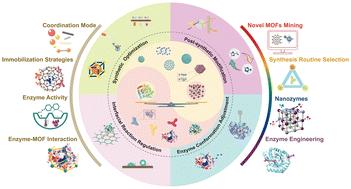探索酶- MOF(金属-有机框架)催化体系:酶活性和MOF稳定性之间的权衡
IF 9.2
1区 化学
Q1 CHEMISTRY, MULTIDISCIPLINARY
引用次数: 0
摘要
酶是一种高效的天然催化剂,广泛应用于绿色生物催化、化工和制药等行业。然而,它们的工业应用往往受到成本高、稳定性差和活性低的限制。金属有机框架(MOFs)以其优异的孔隙度、结构稳定性和可定制性,为酶固定提供了一种可持续的解决方案,显著提高了可持续绿色过程中的稳定性、可重复使用性和催化效率。mof的稳定性往往依赖于苛刻的合成条件,而维持酶活性则需要自然温和的环境。尽管在改善MOF内的酶促性能方面进行了大量的研究,但在酶- MOF混合系统中,MOF稳定性和酶活性之间的权衡仍然只是部分了解。本审查强调了实现这种平衡的关键重要性,总结了enzymes@MOF系统内的关键因素和相互作用,并全面审查了旨在实现这种平衡的最新进展,从而促进可持续绿色催化技术的发展。本文章由计算机程序翻译,如有差异,请以英文原文为准。

Exploring enzyme–MOF (metal–organic framework) catalytic systems: trade-offs between enzyme activity and MOF stability
Enzymes are highly efficient natural catalysts widely used in green biocatalysis, chemical and pharmaceutical industries. However, their industrial applications are often limited by high costs, poor stability, and low activity. Metal–organic frameworks (MOFs), with their exceptional porosity, structural stability, and customizable properties, present a sustainable solution for enzyme immobilization, significantly enhancing stability, reusability, and catalytic efficiency in sustainable green processes. The stability of MOFs often relies on harsh synthesis conditions, while maintaining enzyme activity necessitates natural mild environments. Despite significant research efforts to improve enzymatic performance within MOFs, the trade-offs between MOF stability and enzyme activity in enzyme–MOF hybrid systems remain only partially understood. This review underscores the critical importance of achieving this balance, summarizes the key factors and interactions within enzymes@MOF systems, and provides a comprehensive review of recent advancements aimed at striking this equilibrium, thereby fostering the development of sustainable green catalytic technologies.
求助全文
通过发布文献求助,成功后即可免费获取论文全文。
去求助
来源期刊

Green Chemistry
化学-化学综合
CiteScore
16.10
自引率
7.10%
发文量
677
审稿时长
1.4 months
期刊介绍:
Green Chemistry is a journal that provides a unique forum for the publication of innovative research on the development of alternative green and sustainable technologies. The scope of Green Chemistry is based on the definition proposed by Anastas and Warner (Green Chemistry: Theory and Practice, P T Anastas and J C Warner, Oxford University Press, Oxford, 1998), which defines green chemistry as the utilisation of a set of principles that reduces or eliminates the use or generation of hazardous substances in the design, manufacture and application of chemical products. Green Chemistry aims to reduce the environmental impact of the chemical enterprise by developing a technology base that is inherently non-toxic to living things and the environment. The journal welcomes submissions on all aspects of research relating to this endeavor and publishes original and significant cutting-edge research that is likely to be of wide general appeal. For a work to be published, it must present a significant advance in green chemistry, including a comparison with existing methods and a demonstration of advantages over those methods.
 求助内容:
求助内容: 应助结果提醒方式:
应助结果提醒方式:


